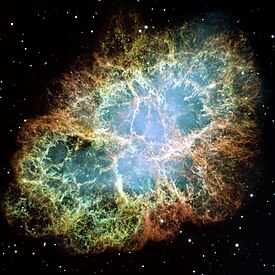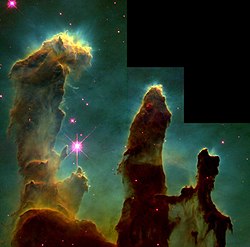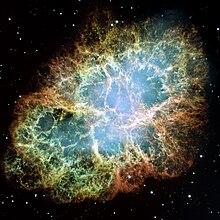Nebula

A nebula (Latin for "cloud";[1] pl. nebulae, nebulæ, or nebulas) is an interstellar cloud of dust, hydrogen, helium and other ionized gases. Originally, nebula was a name for any diffuse astronomical object, including galaxies beyond the Milky Way. The Andromeda Galaxy, for instance, was referred to as the Andromeda Nebula (and spiral galaxies in general as "spiral nebulae") before the true nature of galaxies was confirmed in the early 20th century by Vesto Slipher, Edwin Hubble and others.
Most nebulae are of vast size, reaching sizes of even hundreds of light years in diameter, yet they appear as small clouds to the naked eye.[2] Although denser than the space surrounding them, most nebulae are far less dense than any vacuum created in an Earthen environment - a nebular cloud the size of the Earth would weigh only a few kilograms.

Nebulae are often star-forming regions, such as in the Eagle Nebula. This nebula is depicted in one of NASA's most famous images, the "Pillars of Creation". In these regions the formations of gas, dust, and other materials "clump" together to form larger masses, which attract further matter, and eventually will become massive enough to form stars. The remaining materials are then believed to form planets, and other planetary system objects.
Observational history


Around 150 AD, Claudius Ptolemaeus (Ptolemy) recorded, in books VII-VIII of his Almagest, five stars that appeared nebulous. He also noted a region of nebulosity between the constellations Ursa Major and Leo that was not associated with any star.[4] The first true nebula, as distinct from a star cluster, was mentioned by the Persian/Muslim astronomer, Abd al-Rahman al-Sufi, in his Book of Fixed Stars (964).[5] He noted "a little cloud" where the Andromeda Galaxy is located.[6] He also cataloged the Omicron Velorum star cluster as a "nebulous star" and other nebulous objects, such as Brocchi's Cluster.[5] The supernova that created the Crab Nebula, the SN 1054, was observed by Arabic and Chinese astronomers in 1054.[7][8]
On 26 November 1610, Nicolas-Claude Fabri de Peiresc discovered the Orion Nebula using a telescope. This nebula was also observed by Johann Baptist Cysat in 1618. However, the first detailed study of the Orion Nebula wouldn't be performed until 1659 by Christiaan Huygens, who also believed himself to be the first person to discover this nebulosity.[6]
In 1715, Edmund Halley published a list of six nebulae.[9] This number steadily increased during the century, with Jean-Philippe de Cheseaux compiling a list of 20 (including eight not previously known) in 1746. From 1751–53, Nicolas Louis de Lacaille cataloged 42 nebulae from the Cape of Good Hope, with most of them being previously unknown. Charles Messier then compiled a catalog of 103 "nebulae" (now called Messier objects, which included what are now known to be galaxies) by 1781; his interest was detecting comets, and these were objects that might be mistaken for them, wasting time.[10]
The number of nebulae was then greatly expanded by the efforts of William Herschel and his sister Caroline Herschel. Their Catalogue of One Thousand New Nebulae and Clusters of Stars was published in 1786. A second catalog of a thousand was published in 1789 and the third and final catalog of 510 appeared in 1802. During much of their work, William Herschel believed that these nebulae were merely unresolved clusters of stars. In 1790, however, he discovered a star surrounded by nebulosity and concluded that this was a true nebulosity, rather than a more distant cluster.[10]
Beginning in 1864, William Huggins examined the spectra of about 70 nebulae. He found that roughly a third of them had the emission spectrum of a gas. The rest showed a continuous spectrum and thus were thought to consist of a mass of stars.[11][12] A third category was added in 1912 when Vesto Slipher showed that the spectrum of the nebula that surrounded the star Merope matched the spectra of the Pleiades open cluster. Thus the nebula radiates by reflected star light.[13]
In about 1922, following the Great Debate, it had become clear that many "nebulae" were in fact galaxies far from our own.
Slipher and Edwin Hubble continued to collect the spectra from many diffuse nebulae, finding 29 that showed emission spectra and 33 had the continuous spectra of star light.[12] In 1922, Hubble announced that nearly all nebulae are associated with stars, and their illumination comes from star light. He also discovered that the emission spectrum nebulae are nearly always associated with stars having spectral classifications of B1 or hotter (including all O-type main sequence stars), while nebulae with continuous spectra appear with cooler stars.[14] Both Hubble and Henry Norris Russell concluded that the nebulae surrounding the hotter stars are transformed in some manner.[12]
Formation

Many nebulae or stars form from the gravitational collapse of gas in the interstellar medium or ISM. As the material collapses under its own weight, massive stars may form in the center, and their ultraviolet radiation ionizes the surrounding gas, making it visible at optical wavelengths. Examples of these types of nebulae are the Rosette Nebula and the Pelican Nebula. The size of these nebulae, known as HII regions, varies depending on the size of the original cloud of gas. New stars are formed in the nebulae. The formed stars are sometimes known as a young, loose cluster.
Some nebulae are formed as the result of supernova explosions, the death throes of massive, short-lived stars. The materials thrown off from the supernova explosion are ionized by the energy and the compact object that it can produce. One of the best examples of this is the Crab Nebula, in Taurus. The supernova event was recorded in the year 1054 and is labelled SN 1054. The compact object that was created after the explosion lies in the center of the Crab Nebula and is a neutron star.
Other nebulae may form as planetary nebulae. This is the final stage of a low-mass star's life, like Earth's Sun. Stars with a mass up to 8–10 solar masses evolve into red giants and slowly lose their outer layers during pulsations in their atmospheres. When a star has lost enough material, its temperature increases and the ultraviolet radiation it emits can ionize the surrounding nebula that it has thrown off. The nebula is almost 97% hydrogen and 3% helium, plus trace amounts of other elements.
Types of nebulae
-
The Omega Nebula, an example of an emission nebula
-
The Horsehead Nebula, an example of a dark nebula.
-
The Cat's Eye Nebula, an example of a planetary nebula.
-
The Red Rectangle Nebula, an example of a protoplanetary nebula.
-
The delicate shell of SNR B0509-67.5
Classical types
Objects named nebulae belong to four major groups. Before their nature was understood, galaxies ("spiral nebulae") and star clusters too distant to be resolved as stars were also classified as nebulae, but no longer are.
- H II regions, large diffuse nebulae containing ionized hydrogen
- Planetary nebulae
- Supernova remnant (e.g., Crab Nebula)
- Dark nebula
Not all cloud-like structures are named nebulae; Herbig–Haro objects are an example.
Diffuse nebulae


Most nebulae can be described as diffuse nebulae, which means that they are extended and contain no well-defined boundaries.[18] In visible light these nebulae may be divided into emission and reflection nebulae. Emission nebulae emit spectral line radiation from ionized gas (mostly ionized hydrogen);[19] they are often called HII regions (the term "HII" is used in professional astronomy to refer to ionized hydrogen).
Reflection nebulae themselves do not emit significant amounts of visible light, but are near stars and reflect light from them.[19] Similar nebulae not illuminated by stars do not exhibit visible radiation, but may be detected as opaque clouds blocking light from luminous objects behind them; they are called "dark nebulae".[19]
Although these nebulae have different visibility at optical wavelengths, they are all bright sources of infrared emission, chiefly from dust within the nebulae.[19]
Planetary nebulae

Planetary nebulae form from the gaseous shells that are ejected from low-mass asymptotic giant branch stars when they transform into white dwarfs.[19] They are emission nebulae with spectra similar to those of emission nebulae found in star formation regions.[19] Technically they are HII regions, because most hydrogen will be ionized, but they are denser and more compact than the nebulae in star formation regions.[19] Planetary nebulae were given their name by the first astronomical observers who became able to distinguish them from planets, who tended to confuse them with planets, of more interest to them. Our Sun is expected to spawn a planetary nebula about 12 billion years after its formation.[20]
Protoplanetary nebula
A protoplanetary nebula (PPN) is an astronomical object which is at the short-lived episode during a star's rapid stellar evolution between the late asymptotic giant branch (LAGB) phase and the following planetary nebula (PN) phase.[21] During the AGB phase, the star undergoes mass loss, emitting a circumstellar shell of hydrogen gas. When this phase comes to an end, the star enters the PPN phase.
The PPN is energized by the central star, causing it to emit strong infrared radiation and become a reflection nebula. Collaminated stellar winds from the central star shape and shock the shell into an axially symmetric form, while producing a fast moving molecular wind.[22] The exact point when a PPN becomes a planetary nebula (PN) is defined by the temperature of the central star. The PPN phase continues until the central star reaches a temperature of 30,000 K, after which is it hot enough to ionize the surrounding gas.[23]
Supernova remnants

A supernova occurs when a high-mass star reaches the end of its life. When nuclear fusion in the core of the star stops, the star collapses. The gas falling inward either rebounds or gets so strongly heated that it expands outwards from the core, thus causing the star to explode.[19] The expanding shell of gas forms a supernova remnant, a special diffuse nebula.[19] Although much of the optical and X-ray emission from supernova remnants originates from ionized gas, a great amount of the radio emission is a form of non-thermal emission called synchrotron emission.[19] This emission originates from high-velocity electrons oscillating within magnetic fields.
Notable named nebulae
Nebula catalogs
See also
- H I region
- H II region
- List of diffuse nebulae
- Lists of nebulae
- Molecular cloud
- Magellanic Clouds
- Messier object
- Nebulae in fiction
- Nebular hypothesis
- Orion Molecular Cloud Complex
- Timeline of knowledge about the interstellar and intergalactic medium
References
- ^ Nebula, Online Etymology Dictionary
- ^ 'Formey, Johann Heinrich Samuel. "Nebula." The Encyclopedia of Diderot & d'Alembert Collaborative Translation Project. Translated by Amanda Oberski. Ann Arbor: Michigan Publishing, University of Michigan Library, 2011. Web. 1 April 2015. <http://hdl.handle.net/2027/spo.did2222.0002.664>. Trans. of "Nébuleux," Encyclopédie ou Dictionnaire raisonné des sciences, des arts et des métiers, vol. 11. Paris, 1765.'
- ^ Famous Space Pillars Feel the Heat of Star's Explosion – Jet Propulsion Laboratory
- ^ Kunitzsch, P. (1987), "A Medieval Reference to the Andromeda Nebula" (PDF), ESO Messenger, 49: 42–43, Bibcode:1987Msngr..49...42K, retrieved 2009-10-31
- ^ a b Kenneth Glyn Jones (1991). Messier's nebulae and star clusters. Cambridge University Press. p. 1. ISBN 0-521-37079-5.
- ^ a b Harrison, T. G. (March 1984). "The Orion Nebula — where in History is it". Quarterly Journal of the Royal Astronomical Society. 25 (1): 70–73. Bibcode:1984QJRAS..25...65H.
- ^ Lundmark K. (1921), Suspected New Stars Recorded in the Old Chronicles and Among Recent Meridian Observations'', Publications of the Astronomical Society of the Pacific, v. 33, p.225
- ^ Mayall N.U. (1939), The Crab Nebula, a Probable Supernova, Astronomical Society of the Pacific Leaflets, v. 3, p.145
- ^ Halley, E. (1714–16). "An account of several nebulae or lucid spots like clouds, lately discovered among the fixt stars by help of the telescope". Philosophical Transactions. XXXIX: 390–2.
- ^ a b Hoskin, Michael (2005). "Unfinished Business: William Herschel's Sweeps for Nebulae". British Journal for the History of Science. 43: 305–320. Bibcode:2005HisSc..43..305H.
- ^ Watts, William Marshall; Huggins, Sir William; Lady Huggins (1904). An introduction to the study of spectrum analysis. Longmans, Green, and Co. pp. 84–85. Retrieved 2009-10-31.
- ^ a b c Struve, Otto (1937). "Recent Progress in the Study of Reflection Nebulae". Popular Astronomy. 45: 9–22. Bibcode:1937PA.....45....9S.
- ^ Slipher, V. M. (1912). "On the spectrum of the nebula in the Pleiades". Lowell Observatory Bulletin. 1: 26–27. Bibcode:1912LowOB...2...26S.
- ^ Hubble, E. P. (December 1922). "The source of luminosity in galactic nebulae". Astrophysical Journal. 56: 400–438. Bibcode:1922ApJ....56..400H. doi:10.1086/142713.
- ^ "A stellar sneezing fit". ESA/Hubble Picture of the Week. Retrieved 16 December 2013.
- ^ "ALMA Takes Close Look at Drama of Starbirth". ESO Press Release. Retrieved 21 August 2013.
- ^ "VLT Takes a Close Look at NGC 6357". ESO Press Release. Retrieved 21 June 2012.
- ^ "The Messier Catalog: Diffuse Nebulae". SEDS. Archived from the original on 1996-12-25. Retrieved 2007-06-12.
- ^ a b c d e f g h i j F. H. Shu (1982). The Physical Universe. Mill Valley, California: University Science Books. ISBN 0-935702-05-9.
- ^ E. Chaisson; S. McMillan (1995). Astronomy: a beginner's guide to the universe (2nd ed.). Upper Saddle River, New Jersey: Prentice-Hall. ISBN 0-13-733916-X.
- ^ R. Sahai; C. Sánchez Contreras; M. Morris (2005). "A Starfish Preplanetary Nebula: IRAS 19024+0044". Astrophysical Journal. 620 (2): 948–960. Bibcode:2005ApJ...620..948S. doi:10.1086/426469.
- ^ Davis, C. J.; Smith, M. D.; Gledhill, T. M.; Varricatt, W. P. (2005). "Near-infrared echelle spectroscopy of protoplanetary nebulae: probing the fast wind in H2". Monthly Notices of the Royal Astronomical Society. 360 (1): 104–118. arXiv:astro-ph/0503327. Bibcode:2005MNRAS.360..104D. doi:10.1111/j.1365-2966.2005.09018.x.
- ^ Volk, Kevin M.; Kwok, Sun (July 1, 1989). "Evolution of protoplanetary nebulae". Astrophysical Journal, Part 1 (ISSN 0004-637X). 342: 345–363. Bibcode:1989ApJ...342..345V. doi:10.1086/167597.
External links
- Nebulae, SEDS Messier Pages
- Fusedweb.pppl.gov
- Information on star formation, geocities.com
- Clickable table of Messier objects, space-and-telescope.com

![Herbig–Haro object HH 161 and HH 164.[15]](http://upload.wikimedia.org/wikipedia/commons/thumb/2/27/Hubble_Sees_a_Stellar_%22Sneezing_Fit%22_%2811467249715%29.jpg/120px-Hubble_Sees_a_Stellar_%22Sneezing_Fit%22_%2811467249715%29.jpg)




